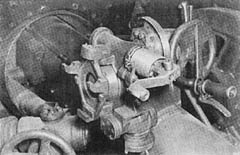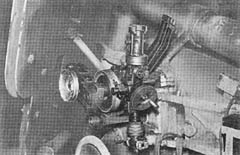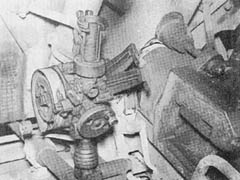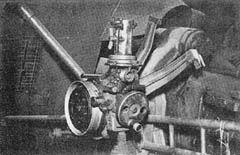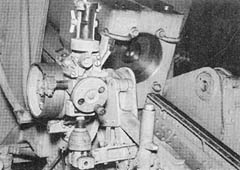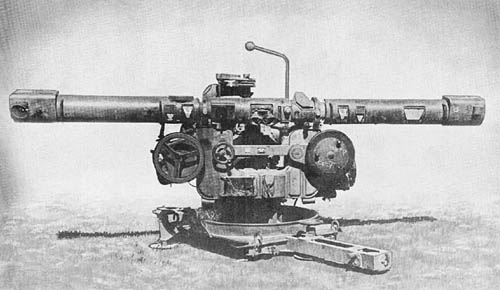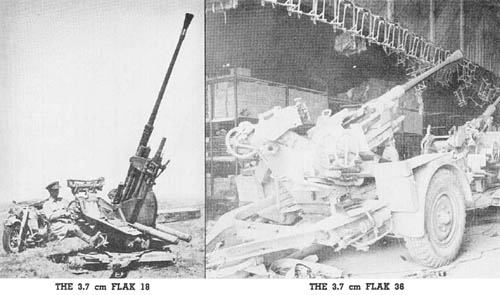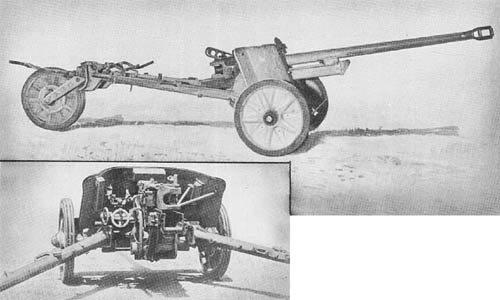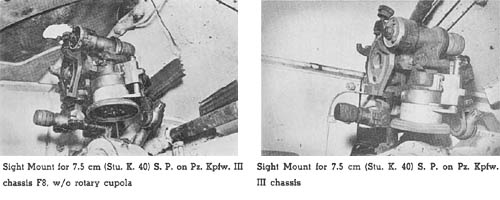
RANGE SCALES: In the above sight mounts there are four scales engraved about the periphery of a vertical range drum. The first scale, used for the Pzgr. 40, is graduated from -300 to 1400 meters; the second for the Spr. is graduated from 100 to 3300 meters, and the third for the Pzgr. 39, is graduated from 200 to 2400 meters. The fourth scale on the drum is a micrometer for the elevation scale located immediately to the right and above the telescope bracket. The elevation scale is graduated in units of 100 mils from 0 to 500.
MOUNTS: The telescope mount for the 7.5 cm Stu. K. 40 is attached to a bracket to the left of the weapon and is connected by a linkage bar so that elevation of the weapon is relayed to the telescope mount. The mount does not automatically compensate for trunnion cant. The telescope used with mounts of this type is of periscopic design and has a removable head. Quadrant elevation is obtained by placing the range drum index in agreement with the proper scale and depressing the telescope mount through the super-elevation angle necessary for the range and then elevating the gun until the apex of the triangle on the telescope reticle is superimposed on the target. There is no angle of site mechanism on the telescope mount, nor is there a longitudinal level vial or index arm to indicate when the gun has been moved through an angle equal to the original movement of the telescope mount. Deflection is introduced by operating the knurled knob at the top-right of the instrument. The deflection scale is graduated in increments of one mil from 0 to 20 on each side of zero.
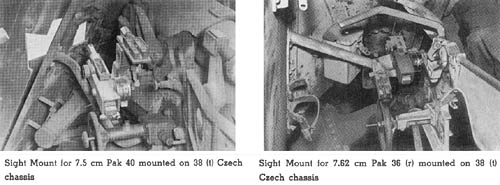
MOUNTS: The telescope mounts for these two guns are of the same general design, the only differences being in the ballistic cam and markings on the range drum. They are of the rocking bar type and have a range drum graduated for the various types of ammunition used in the weapons. A three power, straight tube telescope is used as the sighting component. For indirect fire, a panoramic telescope, the Aushilfsrichmittel 38 can be fitted.
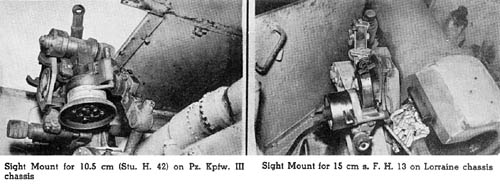
Sight Mount for 10.5 cm (Stu. H. 42) on Pz. Kpfw. III chassis.
RANGE SCALES: There are three scales engraved above the range drum: the top scale is the elevation micrometer for the elevation scale which is graduated from 0 to 300 mils; the next, a range scale, used with the Spr. F. H. Gr., is graduated from 100 to 3300 meters; and the third scale, for the 10.5 cm Gr. 39 HL/A, HL 18, is graduated from 400 to 1500 meters.
MOUNT: The telescope mount for the 10.5 cm Stu. H. 42 is basically the same as the telescope mount for the 7.5 cm Stu. K. 40. The principles of operation are identical.
Sight Mount for 15 cm s. F. H. 13 on Lorraine chassis.
RANGE DRUM: The range drum is quite broad, but there are only two scales on it. The first is a range scale graduated from 100 to 8150 meters. The inner scale is engraved from 0 to 800 mils in 2 mil steps. An elevation scale graduated in units of 100 mils is engraved on a plate fastened to the left trunnion bearing. This scale in conjunction with a pointer actuated by the gun trunnion indicates the angle of elevation imparted to the gun.
MOUNT: The telescope mount for the 15 cm s. F. H. is not an azimuth compensating type. A panoramic telescope bracket is attached to a rack gear and is moved through vertical angles by operation of the knurled knob in the center of the range drum. Angle of site is introduced by turning a wing nut immediately below the telescope bracket. The angle of site scale is engraved about a spiral groove cut into a plate; the index is fitted with a lug that fits in the groove and raises up or down as the scale is turned. Operation of the angle of site mechanism when the range mechanism is locked causes the panoramic telescope to be tilted through an angle equal and opposite to the angle of site. The mount is cross-leveled by turning the wing nut below and forward of the range drum. There is no level vial to indicate a horizontal plane.
German: p. 179, 180, 181
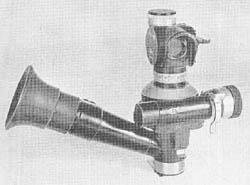 The Rundblickfernrohr 40 is believed to have been designed for use with the
The Rundblickfernrohr 40 is believed to have been designed for use with the 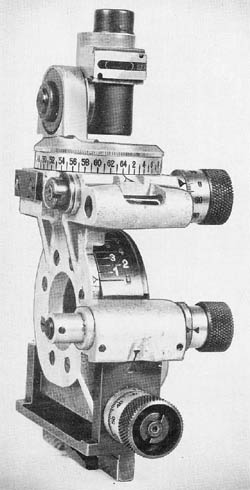 This quadrant sight is called a “substitute aiming device” by the Germans. It will fit into the sight mount found on the 7.62 cm Pak 36 (r), the 5 cm Pak 38, and the 7.5 cm Pak 40. The device has apparently been designed as a cheap instrument for indirect laying and may be used with any weapon having a suitable adapter.
This quadrant sight is called a “substitute aiming device” by the Germans. It will fit into the sight mount found on the 7.62 cm Pak 36 (r), the 5 cm Pak 38, and the 7.5 cm Pak 40. The device has apparently been designed as a cheap instrument for indirect laying and may be used with any weapon having a suitable adapter.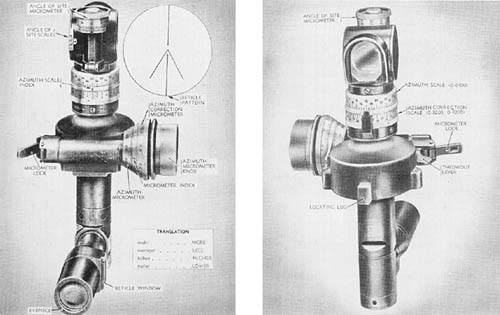
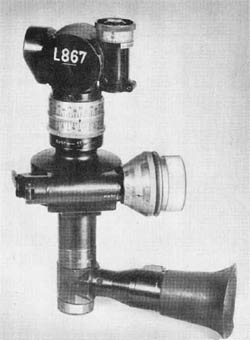 This panoramic telescope is used on all standard field equipment. It is a 4-power, fixed-focus type with a field of view of 10 degrees. The line of sight may be raised or lowered by rotation of the angle of site knob. The angle of site scale is graduated from 100 mils to 500 mils (300 mils in normal). The angle of site micrometer is graduated in mils from 0 to 100 mils. The azimuth scales on the vertical barrel of the telescope are graduated in 100-mil intervals; the upper scale, 0 to 64, is fixed in relation to the rotating head. The lower has two semi-circular scales numbered 0 to 32 and can be rotated independently of the rotating head. A knurled portion permits adjustment. The azimuth micrometer includes two scales graduated in mils from 0 to 100 mils. The outer scale can be rotated independently of the azimuth worm. Evidently the fixed azimuth scale and micrometer are used for initial laying of the piece and the second scale and micrometer are then zeroed and used to measure base deflection. A throw-out lever is provided for rapid setting in azimuth. A locking lever locks the azimuth micrometer in any setting. The reticle pattern is shown above.
This panoramic telescope is used on all standard field equipment. It is a 4-power, fixed-focus type with a field of view of 10 degrees. The line of sight may be raised or lowered by rotation of the angle of site knob. The angle of site scale is graduated from 100 mils to 500 mils (300 mils in normal). The angle of site micrometer is graduated in mils from 0 to 100 mils. The azimuth scales on the vertical barrel of the telescope are graduated in 100-mil intervals; the upper scale, 0 to 64, is fixed in relation to the rotating head. The lower has two semi-circular scales numbered 0 to 32 and can be rotated independently of the rotating head. A knurled portion permits adjustment. The azimuth micrometer includes two scales graduated in mils from 0 to 100 mils. The outer scale can be rotated independently of the azimuth worm. Evidently the fixed azimuth scale and micrometer are used for initial laying of the piece and the second scale and micrometer are then zeroed and used to measure base deflection. A throw-out lever is provided for rapid setting in azimuth. A locking lever locks the azimuth micrometer in any setting. The reticle pattern is shown above.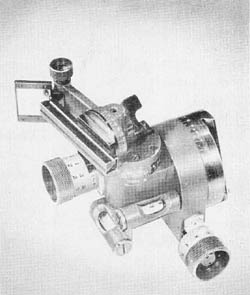 This instrument is designed to be used for laying the German 81 mm Mortar in azimuth and elevation. It embodies means for obtaining right or left lateral deflection, elevation or depression, and a collimator sight for sighting on an aiming point.
This instrument is designed to be used for laying the German 81 mm Mortar in azimuth and elevation. It embodies means for obtaining right or left lateral deflection, elevation or depression, and a collimator sight for sighting on an aiming point.


